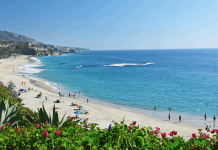It is normal to experience a relatively higher temperature during the dry season or summer. But, some countries feel like summer for the entire year, which makes them considered the hottest countries in the world.
Check out the hottest countries in the world with the highest average daily temperature records. Learn about the different factors that affect their weather condition.

Burkina Faso
This land-locked country records the hottest average temperature in the world. Burkina Faso is found in Africa that lies along the Sahara desert and shares borders with six other nations. The lack of coastline does not allow the cooler air from the Atlantic Ocean to reach this country.

Burkina Faso experiences the blows of hot, dry air from the Sahara desert for more than half the year. This does not explain why the country has a longer dry season than the wet season as it is a tropical country. Burkina Faso is just above the equator.
The average temperature for the entire year of Burkina Faso is 28.25 degrees Celsius or 82.85 degrees Fahrenheit. During dry seasons, the maximum temperature can reach over 25°C. Take note that the northern region of the country is relatively hotter because of the Sahel region.
March to May are the months to avoid when planning to visit Burkina Faso as the temperature is too high and the air is too dry. Based on records, the country experienced 47°C at least once.
Mali
Based on reports, Mali’s annual average temperature is relatively close to Burkina Faso’s temperature, with 28.25 degrees Celsius or 82.85 degrees Fahrenheit. Mali also borders Burkina Faso and is also a landlocked country in the western part of Africa.

The large portion of the northern part of Mali lies within the Sahara desert, while the southern region is along the Sahel region. Mali experiences over 43 degrees Celsius or 110 Fahrenheit on a typical day from June to September.
Kayes, Mali records up to 44°C or 111.2°F on average in April, thus gaining the tagline “Pressure Cooker of Africa.” The stifling temperature year-round in the country makes it unbearable for the locals.
The highest recorded temperature in the country is 54°C.
Kiribati
Kiribati records an average daily temperature of 28.20°C or 82.76°F, and its location is the main reason it experiences intense heat all year round. The country lies along the equator, which places the sun directly above Kiribati most of the time.

There is not much variation in the daily temperature in the country for the entire year. Kiribati also experiences the effect of the warm tropical Pacific waters that bring humidity. Interestingly, the country typically experiences El Niño and La Niña.
The phenomenon causes drought in the country because the eastern current from South America, which brings relatively cooler currents and air, slows down. The major islands of the country have different periods when they experience lesser rainfall.
Kiribati holds the record of having 46°C as the highest temperature measured ever.
Tuvalu
Tuvalu is a nine-island nation located on the equator and is between Hawaii and Australia. The country has an equatorial climate that is hot, humid, and rainy year-round. Tuvalu’s average daily temperature does not vary much and is around 28°C or 82.4°F.

The tropical warm Pacific waters are the biggest contributors to the consistent high temperature in the country. In addition, Tuvalu experiences being directly under the heat of the sun most of the time, especially during the dry season.
Even though the country does not experience scarcity in rainfall, Tuvalu still records a high average daily temperature. The rains may be heavy sometimes, along with thunderstorms, but the pouring period is relatively short, which does not alleviate the day heat.
The country has a consistent temperature day and night. It usually hits 33°C during the daytime and 25°C at night. With the stable temperature, the country records 41°C or 106°F as its highest ever.
Djibouti
Considered to be one of the aridest places globally, Djibouti stands on the Horn of Africa, bordered by Eritrea, Ethiopia, and Somalia. The small country experiences rainfall during the winter along its coastlines and during the summer in the inland area.

However, the rain that Djibouti has is just below 500mm or 20 inches, which is not enough to compensate for the natural hotness and dryness of the area. The country has a scorching daily temperature average of 28°C or 82.4°F.
Djibouti feels the intense heat during summertime as the temperature measures around 36°C to 41°C. Interestingly, the average temperature during the night is the same as the daytime of winter in the country, which is 30°C. This is proof that Djibouti never had that drastic temperature change, even with different seasons.
Djibouti has recorded a whopping 46.1°C or 115°F as the highest temperature experienced in the country.
Senegal
Another African country with its northern part lies in the Sahel region, Senegal, which is subjected to hot weather conditions the entire year. The savannah landscape in Senegal’s central and central areas adds to the reason for the general high temperature of the country.

Senegal has an average daily temperature of 27.85°C or 82.13°F. The weather in the country changes a bit during different seasons. In winter, the country experiences an average of 17°C or 63°F, especially during January. Until May, Senegal only records up to 27°C or 81°F.
Guinea, Mali, and Mauritania border the country. Senegal tallies over 500mm or 20 inches of rainfall, especially from June to August. This is much better compared to its neighboring countries that experience lesser rainfall in a year.
According to reports, Senegal has a record of 50.5°C or 123°F as its highest temperature.
Maldives
The Maldives is one of the most popular island destinations for tourists as the weather for the entire year is suitable to explore the beaches and waters enveloping the small country. The 1192 islands of the Maldives experience hot weather conditions all year round.

This island nation is located in the Indian Ocean in the southwest of the countries India and Sri Lanka. As proof of its hot weather condition, the country records 27.65°C or 81.77°F as its average daily temperature. The Maldives has a much stable temperature throughout.
The temperature ranges from 25°C to 30°C. Monsoons significantly affect the weather in the Maldives. The absences of the monsoon bring on a slight increase in temperature from February to May.
Rain is abundant in the country but does not help alleviate the high temperature as it is usually a short, intense downpour with thunderstorms. 37°C or 99°F is the highest recorded temperature in the Maldives.
Mauritania
The same with the Maldives, Mauritania has a daily average temperature of 27.65°C or 81.77°C and a yearly average of 13°C to 40°C. Also, the country experiences hot temperatures and dry air for most parts of the year, just like its neighboring countries Senegal, Mali, and Algeria.

Mauritania’s land lies within the Sahara desert in the northern part, while the southern part is in the Sahel region. Mauritania has a general hot weather condition combining the dryness from the north and the semi-arid condition in the south.
It has recorded 48°C or 119°F as its highest temperature in history. Even though most parts are dry and hot, the western part of Mauritania is considered the coolest region as it is directly bordering the Atlantic Ocean.
Palau
This west pacific island nation is just above the equator. Palau is located to the east of the Philippines and north of Indonesia. The location of the small country is the biggest reason for its hot and humid weather conditions for the entire year.

Since Palau has an equatorial climate, the weather is usually hot, humid, and rainy. Even though the country experiences consistent rainfalls, it does not affect the islands’ average temperature.
The rain with thunderstorms is overpowered by the warm waters of the Pacific that do not let the land cool down even during the night. Palau has an average daily temperature of 27.6°C or 81.68°F. There is no official dry season in the country because it has a relatively lower rainfall record.
Another interesting fact about the weather condition in Palau is that the temperature does not change much in different months. Palau only recorded 35°C or 95°F as its highest temperature ever.
Benin
This small African country has a tropical climate with a dry season and a rainy season. Benin experiences the rainy season brought on by the African Monsoon from May to September in the north, extending to October in the south.

Benin’s population is heavily settling in the southern part of the country, probably because it has a more friendly weather condition relatively. The southern part receives more rainfall than the north, with 1000mm to 3000mm.
Even though the country overlooks the Gulf of Guinea, the dry season usually lasts up to seven months. This is the reason why Benin has an average daily temperature of 27.55°C or 81.59°F, with 45°C or 113°F as the highest recorded temperature.
Conclusion
These countries hold the record of having consistent high temperatures year long. The common reasons for this phenomenon are their location, climate, other natural settings such as deserts or surrounding waters.

































